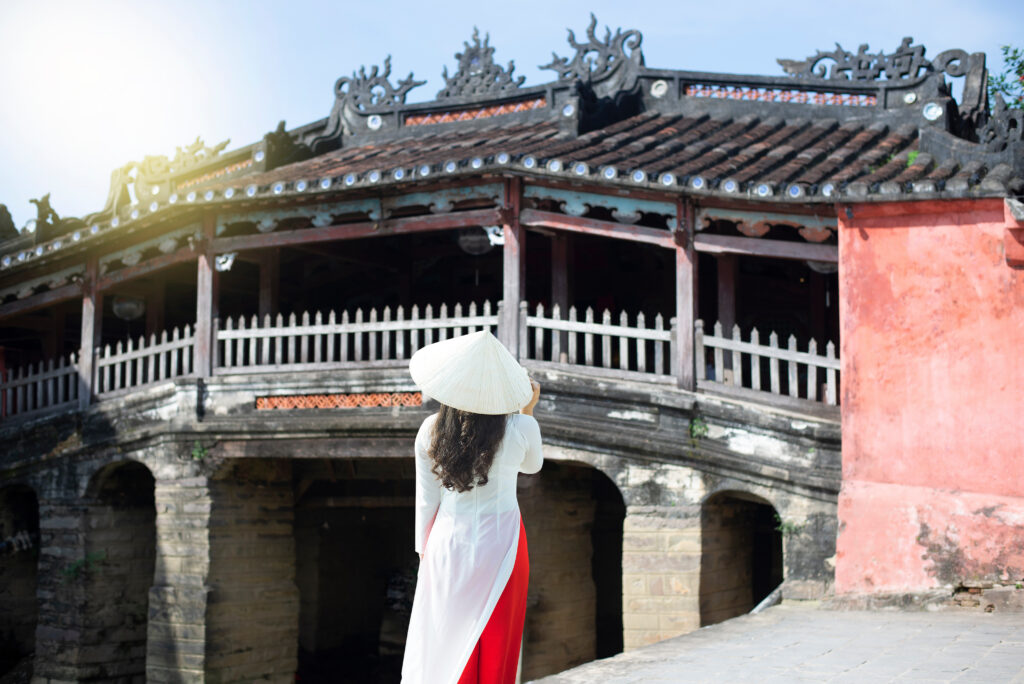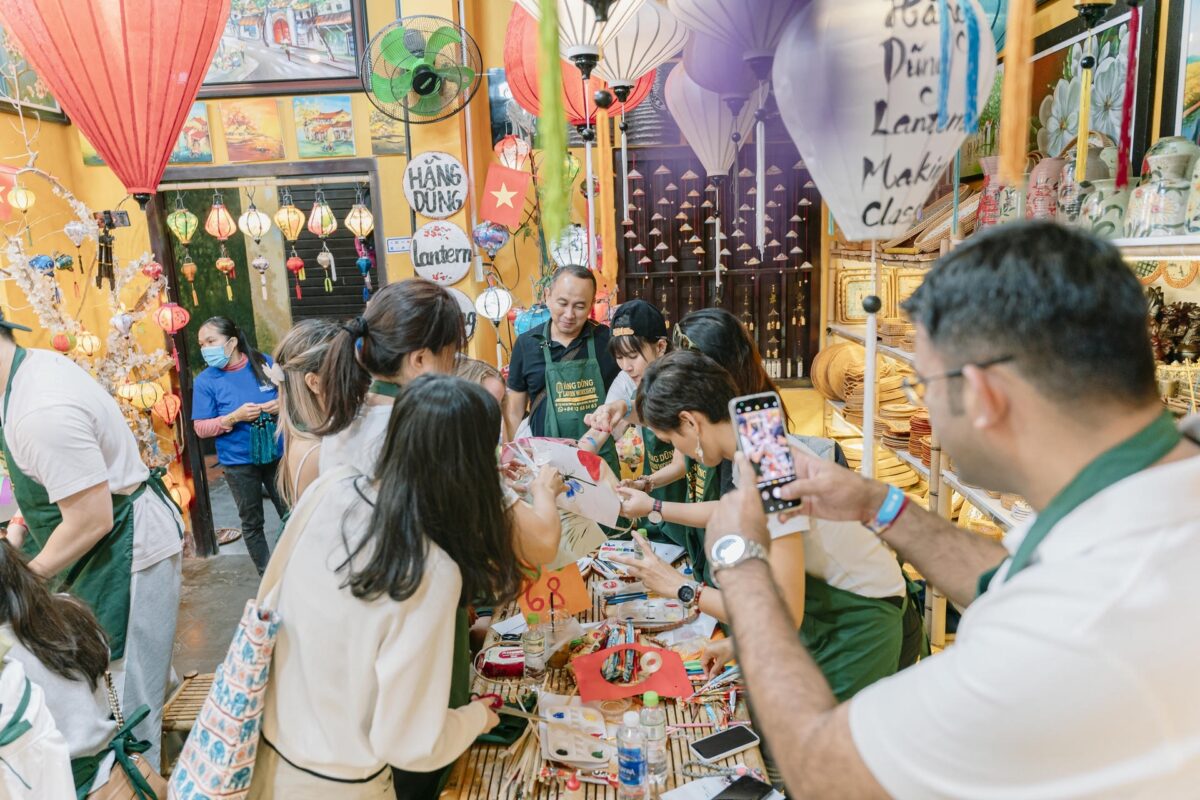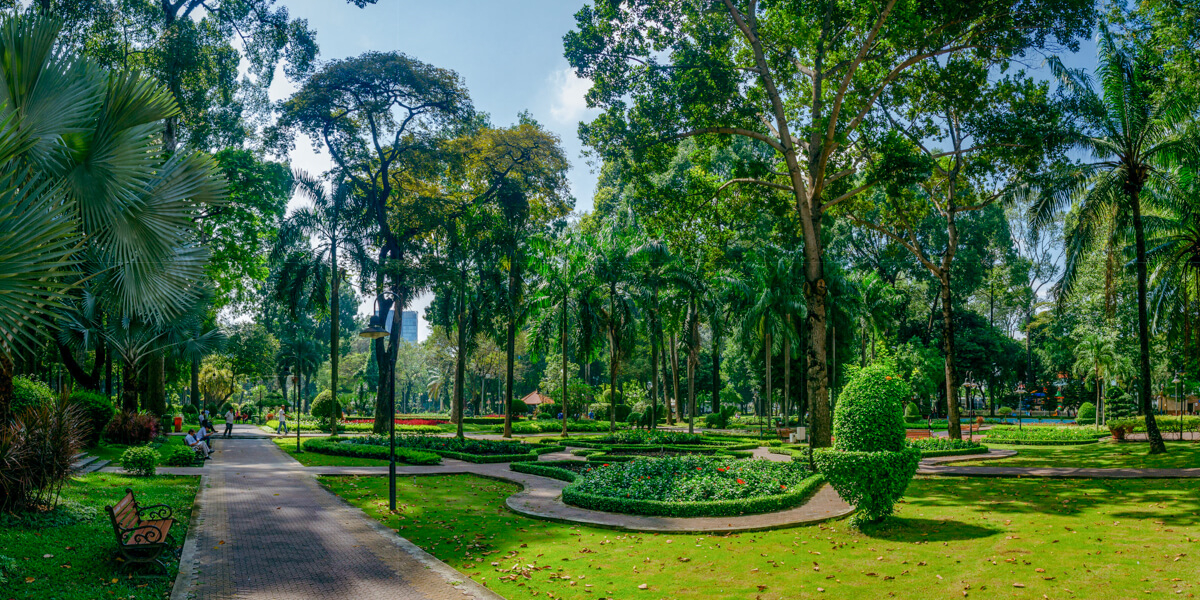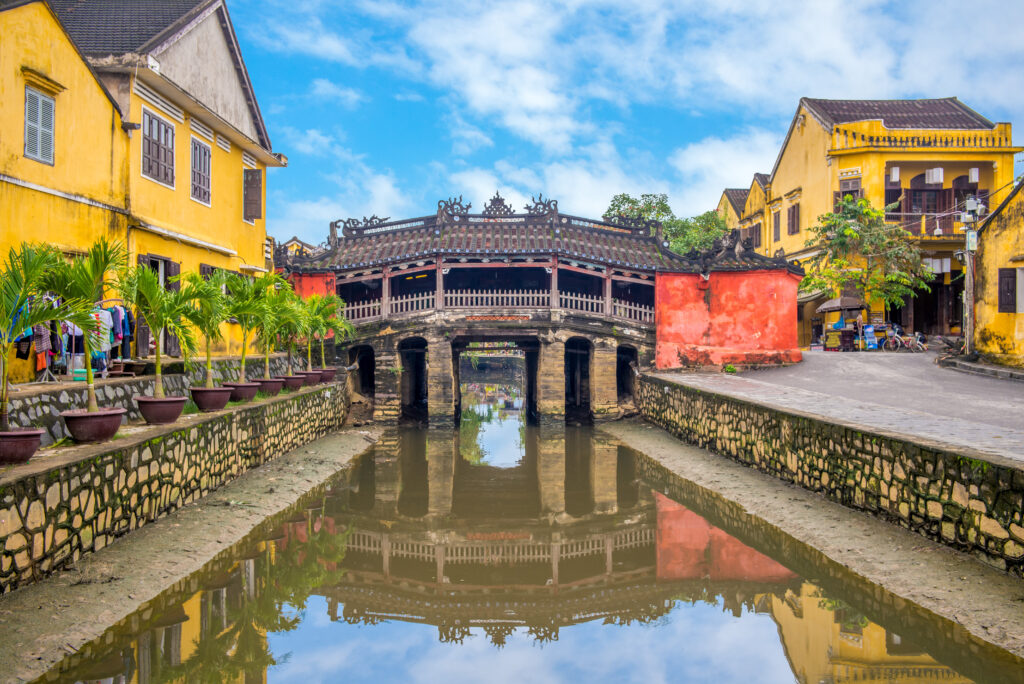
The Japanese Bridge in Hoi An stands as an iconic symbol of Hoi An Ancient Town, celebrated for its architectural beauty and cultural significance. This historic landmark even graces Vietnam’s 20,000 VND banknote, highlighting its importance in the nation’s heritage.
Nestled within Hoi An Ancient Town—a UNESCO World Heritage Site—the Japanese Bridge in Hoi An is one of Vietnam’s most captivating cultural treasures. Constructed in the 17th century, it has borne witness to centuries of change, making it a must-visit attraction for anyone exploring Hoi An City. To make the most of your trip, discover the 15 best things to do in Hoi An and immerse yourself in the town’s rich history and unique charm. A visit to this bridge promises a glimpse into the past and a deeper appreciation of Hoi An’s enduring allure.
About the Japanese Bridge in Hoi An
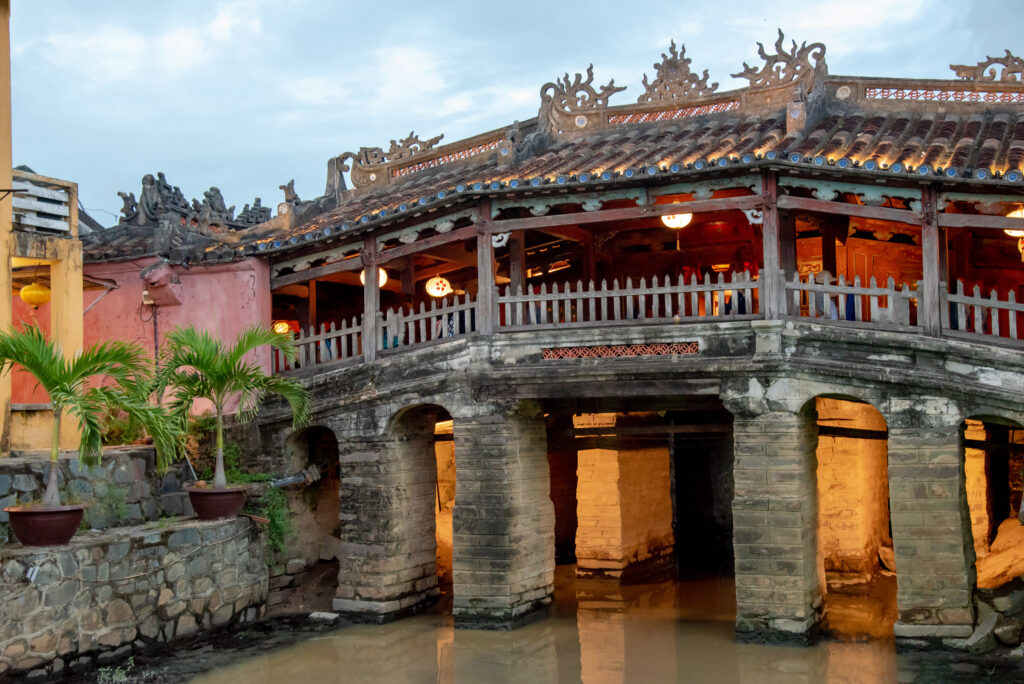
The Japanese Bridge in Hoi An, also known as Cau Pagoda (Chùa Cầu), is a beautiful and enduring symbol of the town’s rich heritage. Nestled within the historic streets of Hoi An Ancient Town, this iconic bridge has become a gateway connecting the past, present, and future, showcasing a blend of Japanese, Chinese, and Vietnamese influences. Its elegant design, captivating history, and significant cultural value make it a top destination for visitors exploring the UNESCO World Heritage Site of Hoi An.
History of the Japanese Bridge in Hoi An
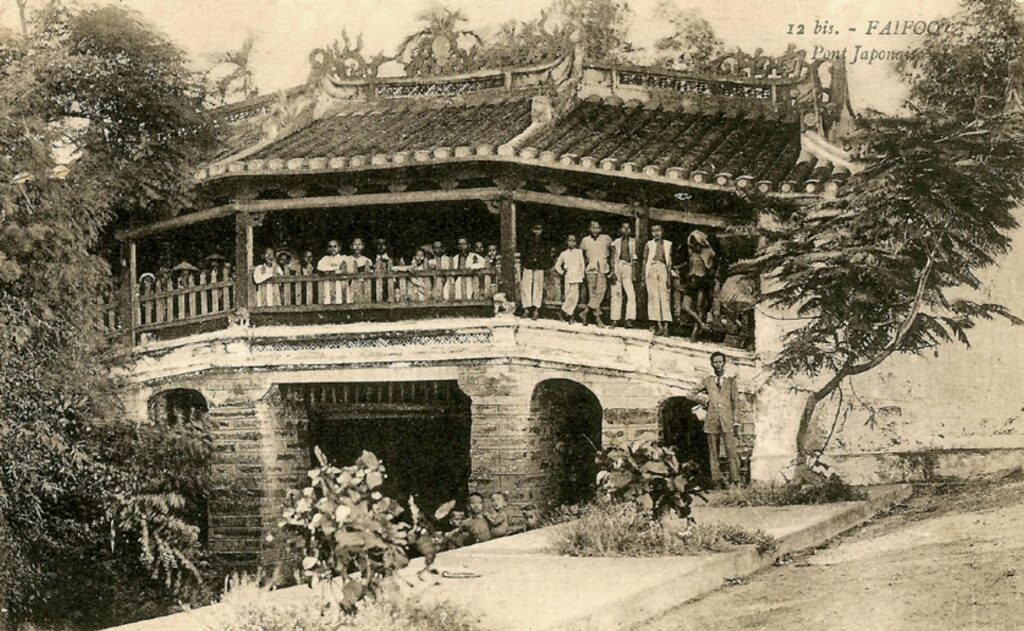
The Japanese Bridge in Hoi An was built in the early 17th century, largely thanks to Japanese merchants who played a vital role in Hoi An’s prosperity as a bustling trading port. This bridge is deeply connected to the legend of Namazu, a powerful mythological monster from Japanese folklore. According to the story, Namazu—a massive creature that could cause earthquakes and floods—stretched from India (its head), through Vietnam (its body), to Japan (its tail). To protect against Namazu’s destructive movements, a magical sword was symbolically placed on the bridge, “pinning down” the creature’s back to bring stability to the lands. This act was believed to prevent natural disasters and bring peace and prosperity to Vietnam, Japan, and India.
The bridge’s importance grew over time. In 1719, Lord Nguyen Phuc Chu visited Hoi An and named it “Lai Vien Kieu” or “the bridge to welcome guests from afar.” This name reflected its purpose as a bridge linking cultures and welcoming traders from different nations. The structure became known as the Japanese Bridge or Japanese Covered Bridge, as it was primarily constructed by the Japanese community and has since retained this name in honor of its origins.
On February 17, 1990, the Japanese Bridge in Hoi An was officially recognized as a National Historic and Cultural Heritage Site. This designation not only acknowledged its historical and architectural significance but also celebrated its role in fostering cultural unity. The bridge’s lasting presence in Hoi An is a testament to the shared history between Vietnam and Japan and reflects a time when the town flourished as a multicultural trading hub.
Today, the Japanese Bridge stands as one of Hoi An’s most cherished landmarks, offering visitors a tangible link to the town’s storied past and a symbol of peace, resilience, and cross-cultural connection.
The Architecture of the Japanese Bridge in Hoi An
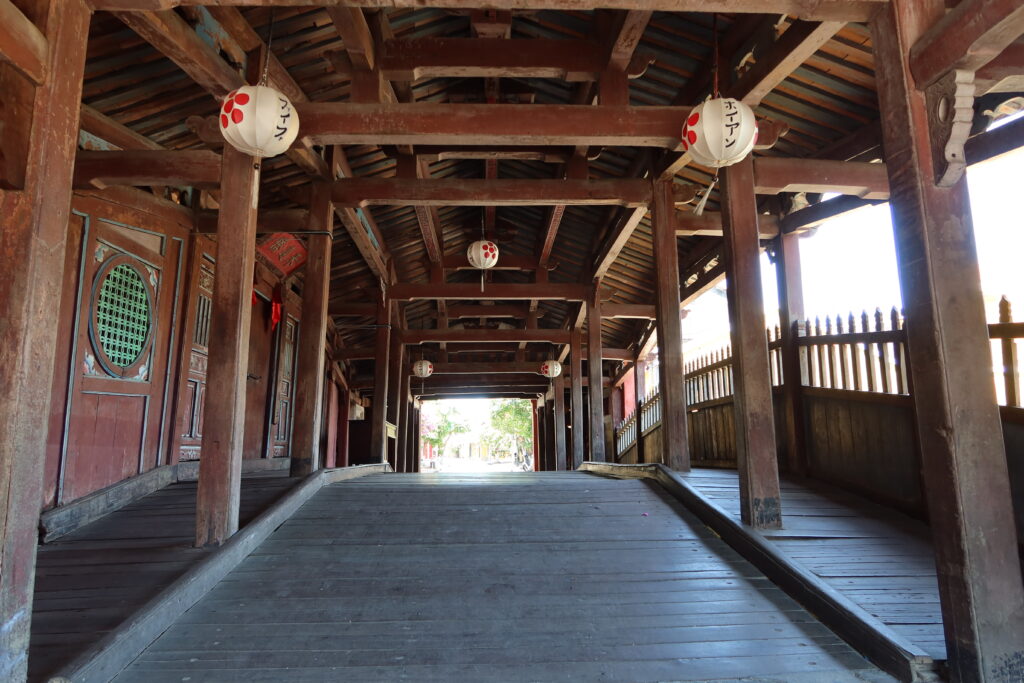
The Japanese Bridge in Hoi An spans 18 meters, linking Tran Phu Street (formerly the Chinese quarter) on the eastern side with Nguyen Thi Minh Khai Street (historically the Japanese quarter) on the western side. This serene structure crosses a tributary of the Thu Bon River, enhancing the tranquil and nostalgic atmosphere that defines Hoi An’s ancient town.
Constructed primarily from red lacquered wood with a sturdy stone foundation, the bridge is an elegant blend of Vietnamese, Japanese, and Chinese architectural elements. Despite its name, the “Japanese Bridge” embodies a fusion of cultural influences, visible in the choice of materials, intricate design, and decorative patterns.
The bridge showcases traditional Japanese architectural style with its gracefully curved roof that shelters the entire structure. The roof is adorned with yin-yang symbols, reflecting Vietnamese cultural beliefs about harmony and balance. These elements of design lend the bridge a unique aesthetic, merging Japanese elegance with Vietnamese symbolism and the decorative traditions of Chinese craftsmanship.
Each side of the bridge has small corridors and benches, offering a peaceful spot for visitors to relax, take in the fresh air, and enjoy views of the water below. The pagoda itself is separated from the main bridge by a slim wooden partition, creating a dedicated, serene space for reflection and respect.
Adding to the bridge’s charm are the statues of a dog and a monkey placed at the entrance and exit, symbolizing the guardians of the bridge. In Japanese culture, these animals represent protection and safety. It’s also believed that these figures may signify the timeline of the bridge’s construction, which began in the year of the Monkey and concluded in the year of the Dog. Together, these statues add a layer of cultural depth and lend an almost mystical quality to the bridge, making it a timeless symbol of Hoi An’s multicultural heritage.
The Japanese Bridge’s blend of artistry, cultural symbolism, and serene beauty makes it one of the most treasured landmarks in Hoi An, captivating all who visit this historic town.
The Renovation of the Japanese Bridge in Hoi An
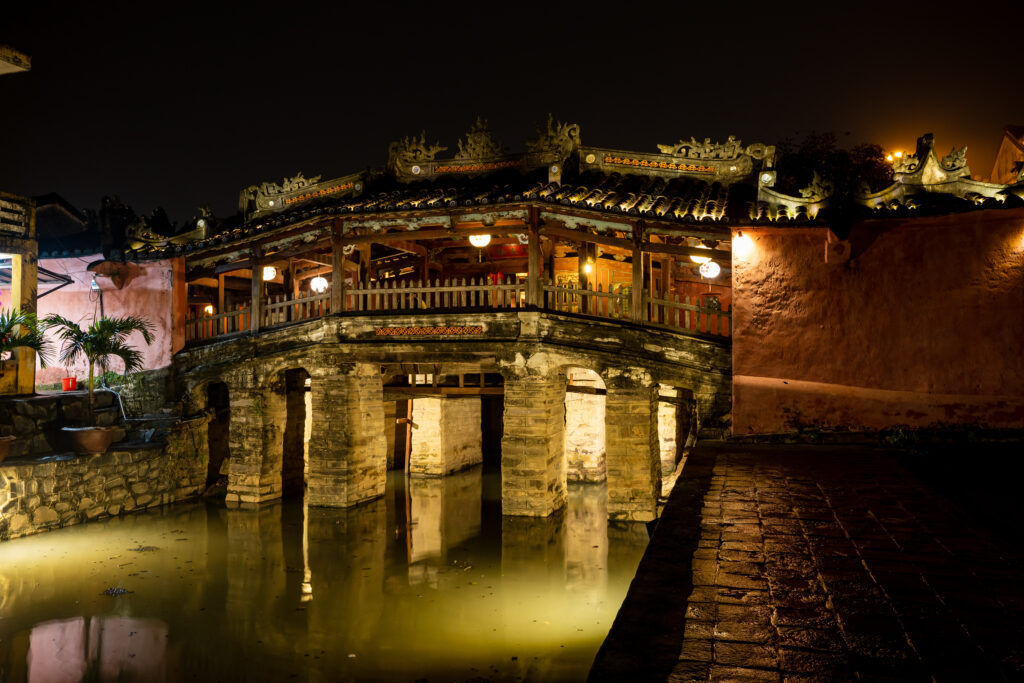
Over its 400-year history, the Japanese Bridge in Hoi An has undergone seven major renovations to preserve its structure and beauty. These restorations, conducted in 1763, 1815, 1875, 1917, 1962, 1986, and 1996, involved various adjustments to the bridge’s roof, floor, and pillars, addressing the natural wear and tear inflicted over centuries.
The first three renovations were managed by the Minh Huong Commune, a village within Hoi An, underscoring the local community’s role in preserving this historic bridge. During the French colonial period in 1917, the French authorities modified the pedestrian-only bridge to support motorized traffic, a change that impacted the bridge’s traditional design and structure.
In 1962, the Quang Nam provincial government initiated another repair, but it wasn’t until 1986 that the bridge was returned to its original pedestrian-only state. The restorations in 1986 and 1996 were especially extensive, involving substantial structural reinforcements to ensure the bridge could withstand the elements while maintaining its historical charm.
Unfortunately, since the last renovation in 1996, the bridge has faced ongoing challenges, particularly from frequent flooding in Hoi An. Many of the poles and beams have weakened, creating an urgent need for structural maintenance. To address this, the Quang Nam provincial government approved a nearly one-million-dollar preservation project in 2020, aiming to reinforce and restore the bridge while preserving its historical significance.
This latest restoration effort underscores the community’s commitment to protecting the Japanese Bridge as a symbol of Hoi An’s cultural heritage. As work progresses, the goal is to preserve the bridge’s beauty and stability for future generations to experience and admire.
How to Get to the Japanese Bridge in Hoi An
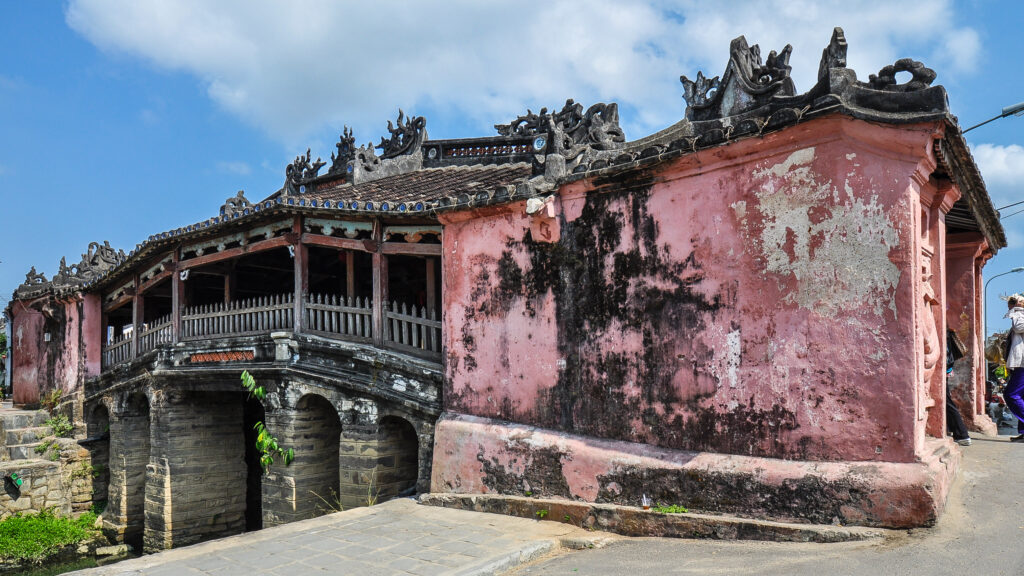
- Address: 186 Tran Phu, Minh An Ward, Hoi An, Quang Nam Province
- Opening Hours: Open 24 hours every day
- Tickets: Free
The Japanese Covered Bridge is located in the heart of Hoi An’s Ancient Town, a short distance from Da Nang. Many travelers include both destinations in their itinerary, and the growing popularity of this route has made transportation between Da Nang and Hoi An both accessible and affordable. Here are some of the best ways to get to Hoi An from Da Nang.
By Bus
For a budget-friendly option, consider taking a bus from Da Nang to Hoi An. Buses run frequently on this route and are a popular choice for both locals and tourists. The fare is usually around 25,000 VND per ticket, making it a great way to save on transportation costs. The buses operate from 5:30 am to 6:00 pm, with a new bus departing roughly every 20 minutes.
While the bus is economical, it can be hot and crowded, especially during peak travel times and holidays. The journey takes about 70-80 minutes, depending on traffic, and stops at main roads like Ton Duc Thang, Dien Bien Phu, and Le Duan in Da Nang and Le Van Hien and Nguyen Van Troi in Hoi An.
By Motorbike
For travelers seeking adventure, renting a motorbike offers flexibility and the chance to enjoy the scenic countryside between Da Nang and Hoi An. There are plenty of motorbike rental shops in Da Nang, with prices ranging from 80,000 to 130,000 VND per day depending on the bike type.
The journey from Da Nang to Hoi An by motorbike takes about one hour. Riding a motorbike provides an opportunity to explore the stunning coastal roads, scenic viewpoints, and quaint villages along the way, making the trip as much about the journey as the destination. Remember to bring identification when renting a bike and to follow all local traffic rules.
By Taxi
If you’re looking for comfort and convenience, a taxi is a direct way to travel from Da Nang to Hoi An. While taxis are the most expensive option, they offer privacy and can accommodate groups, making them more economical when shared. The fare usually ranges between 300,000 and 400,000 VND for the entire journey, which can be split if you’re traveling with friends.
This option is especially recommended if you’re traveling with luggage or if the weather isn’t favorable for motorbike rides.
Interesting Facts About the Japanese Bridge in Hoi An
Before you set foot on the Japanese Bridge in Hoi An, consider these intriguing facts that add depth to its cultural and historical significance. This bridge is more than just a scenic spot—it’s a revered symbol with a story deeply rooted in Vietnamese heritage.
The Japanese Bridge in Hoi An is Featured on Vietnam’s Currency
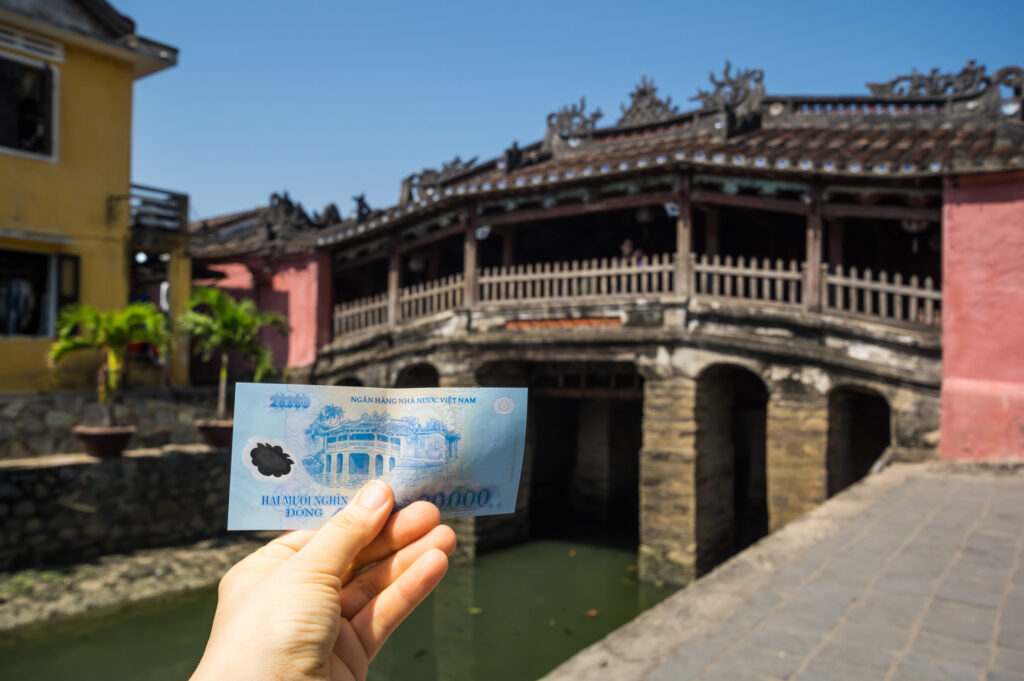
A testament to its cultural importance, the Japanese Bridge in Hoi An is featured on Vietnam’s 20,000 VND banknote, making it one of the few landmarks in the country to hold this honor. Its presence on the currency underscores its value as a national icon, representing Hoi An’s rich heritage and the enduring connection between Vietnam and Japan. The image of the bridge on the banknote immortalizes its historical significance, showing that it’s more than just a tourist attraction—it’s a cherished emblem of Hoi An Ancient Town and a beloved symbol of Vietnamese culture.
The Japanese Bridge’s Temple Venerates a Unique Deity
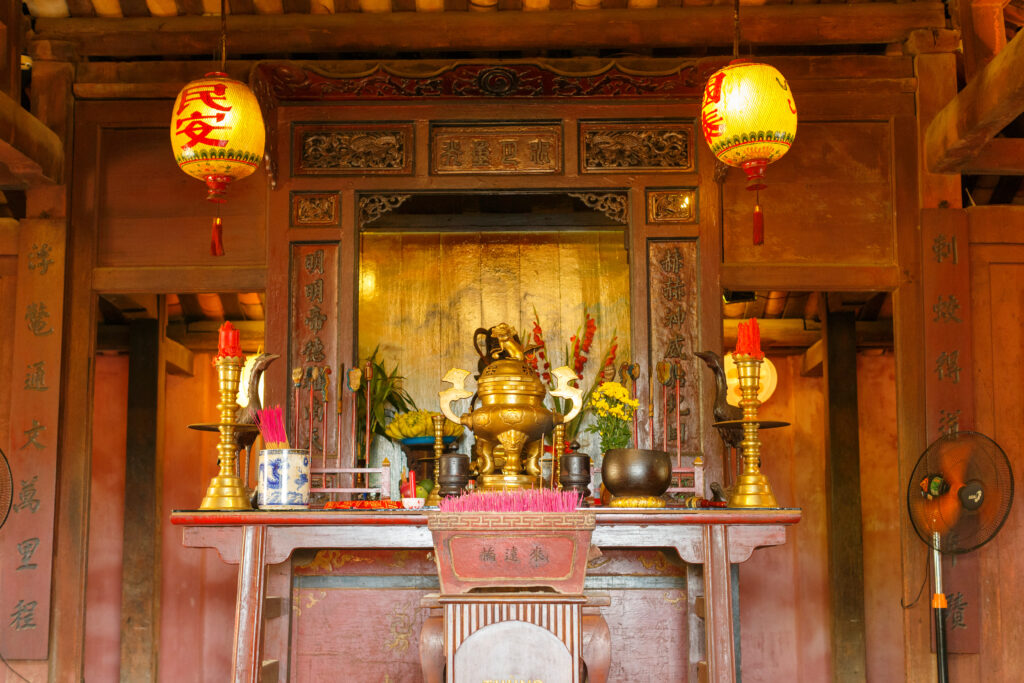
Unlike most temples in Vietnam that are dedicated to Buddha, the temple within the Japanese Bridge in Hoi An—known as Cau Pagoda—honors Tran Vo Bac De, a northern deity revered as the god of happiness, wealth, and health. This makes the Japanese Bridge not only an architectural marvel but also a spiritual haven where locals come to seek blessings and peace of mind. For the people of Hoi An, the deity’s presence within the bridge reflects their wishes for prosperity, harmony, and a balanced life. Visitors are often fascinated by this unique blend of religious practices that reflect the cultural exchanges and beliefs that have shaped the region over centuries.
The Japanese Bridge in Hoi An is Comprised of Two Distinct Sections
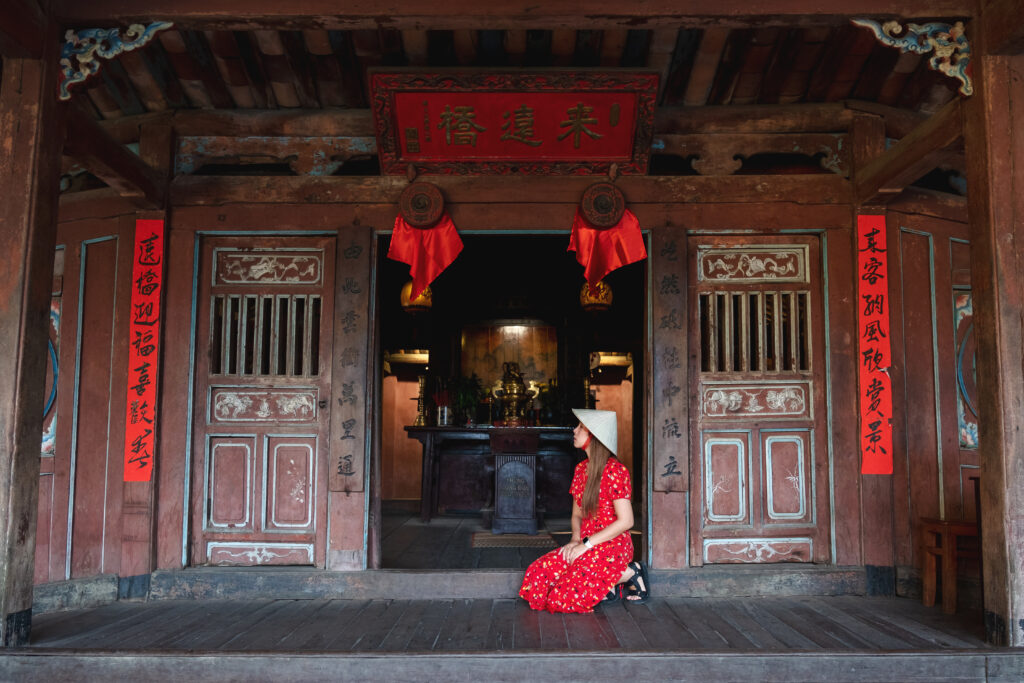
The Japanese Covered Bridge has a dual-purpose structure, consisting of a bridge and a temple, each with its own character and purpose. This is why the site is called “Chua Cau” in Vietnamese (“Chua” meaning “temple” and “Cau” meaning “bridge”). The bridge, originally built to span the Thu Bon River, connected different sections of Hoi An and facilitated travel between them. Sixty years after the bridge’s completion, the temple was added to the northern end, enhancing the bridge’s cultural and spiritual importance. This dual structure symbolizes both the practical and spiritual values upheld by Hoi An’s residents. Visitors exploring the bridge can appreciate its historical architecture while also immersing themselves in its peaceful spiritual atmosphere, finding a rare combination of utility and reverence in one place.
In every way, the Japanese Bridge in Hoi An stands as a testament to the city’s unique blend of history, spirituality, and cross-cultural connections, inviting all who cross it to reflect on the timeless values it represents.
Tips for Visiting the Japanese Bridge in Hoi An
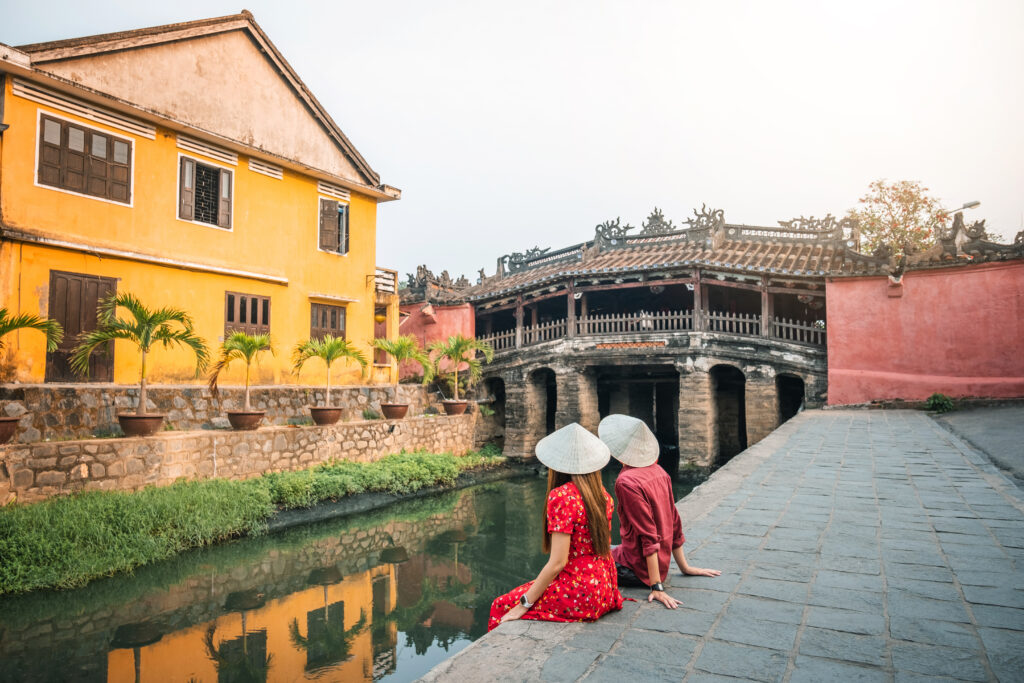
To make the most of your experience at this iconic landmark, here are some helpful tips to enrich your visit to the Japanese Bridge and its surroundings.
Visit The Japanese Bridge in Hoi An During Off-Peak Hours
The ideal time to explore the Japanese Bridge is between 9:00 a.m. and 3:00 p.m. when crowds are usually smaller. This allows you to fully appreciate the intricate details of the bridge without the bustle of larger groups. If you prefer a quieter visit, early mornings and late afternoons provide a more serene atmosphere.
Enjoy Evening Activities in Hoi An Ancient Town
Beyond the Japanese Bridge, the Old Town offers nightly entertainment, with folk games and street performances taking place from 7:00 p.m. to 8:30 p.m. Strolling through the lively streets during these hours offers a closer look at Hoi An’s traditional arts and cultural expressions.
Take a Bamboo Boat Cruise at Night
For an unforgettable experience, consider a bamboo boat cruise along the canal at night. With the town illuminated by lanterns, the scenery becomes even more enchanting. Gliding along the river under soft lights allows you to feel the tranquil charm of Hoi An, capturing the spirit of the ancient town from a unique perspective.
Hire a Knowledgeable Tour Guide
To gain deeper insights, hiring a tour guide is recommended. Guides can share fascinating details about the bridge’s history, its unique architecture, and the significance of various elements you might otherwise miss. They can also provide guidance on other landmarks and make your visit more informative and memorable.
Explore Nearby Attractions
After your time at the Japanese Bridge, explore nearby heritage sites such as Quan Cong Temple, Phuc Kien Assembly Hall, and the Tan Ky Ancient House. These spots are within walking distance and each offers a glimpse into Hoi An’s vibrant past and architectural beauty. Visiting these locations rounds out your historical tour of Hoi An, offering a comprehensive view of the town’s rich heritage.
By planning with these tips in mind, you’ll experience the best of Hoi An’s cultural treasures, enjoying both the Japanese Bridge and the myriad of wonders surrounding it.
What to Do at the Japanese Bridge in Hoi An
Explore the Rich History of the Japanese Bridge in Hoi An
Visiting the Japanese Bridge without delving into its fascinating history would be a missed opportunity. This bridge-pagoda hybrid holds a unique place in Vietnamese culture, making it stand out from other temples and bridges across Vietnam. Learning about why it was built, the legend of the mythological creature Namazu it’s associated with, and its historical purpose enhances the experience. Standing on the bridge where centuries of stories have unfolded allows you to connect with the past in a tangible way, hearing the echoes of the stories that make it a symbol of Hoi An.
Admire the Distinctive Architecture of the Japanese Bridge in Hoi An
The Japanese Bridge in Hoi An is celebrated for its one-of-a-kind architectural style, blending a bridge with a pagoda across the serene Hoai River. Its structure, with distinct Japanese cultural influences, makes it immediately recognizable among Vietnam’s temples and pagodas. Every detail, from the gracefully curved tile roof to the intricate carvings on its wooden walls, showcases Japanese craftsmanship with a touch of local flavor. The bridge’s elegance truly comes alive at night when illuminated by vibrant lanterns, casting a warm glow that adds to its mystical beauty. Capture the bridge’s charm with photos—its nighttime appearance, draped in colorful lights, creates a magical scene that lingers in memory.
Let’s Wrap It Up
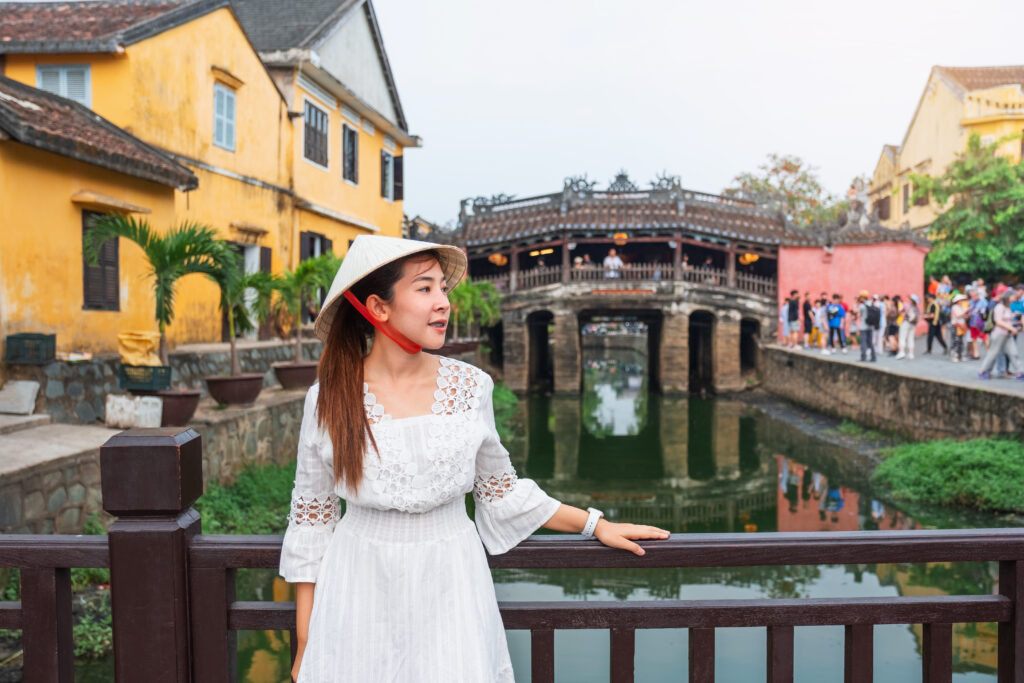
Visiting the Japanese Bridge in Hoi An is more than just a sightseeing stop; it’s an experience that transports you to the heart of Vietnam’s rich history and multicultural heritage. Standing on this iconic bridge, one can almost feel the whispers of the past, woven into each wooden beam and every intricate carving. The bridge represents centuries of cultural exchange, resilience, and a profound respect for tradition. Exploring this unique structure, with its fascinating blend of Japanese, Vietnamese, and Chinese influences, offers a rare glimpse into Hoi An’s soul.
Whether you’re captivated by the bridge’s timeless architecture, intrigued by the myths surrounding its construction, or simply soaking in the serene beauty of the surrounding river, a visit to the Japanese Bridge is a truly unforgettable experience. It’s a reminder of the quiet, enduring charm that makes Hoi An so special—a place where stories from the past live on, inviting us to pause, appreciate, and carry a piece of this remarkable culture with us long after we leave.
For more ways to explore Vietnam and its dynamic cities, check out our other articles:
- 25 unusual things to do in Ho Chi Minh
- 12 must-do tours in Ho Chi Minh
- 26 highlights in Ho Chi Minh’s Chinatown
- 20 Things To Do In Ho Chi Minh City At Night
- 25 Things to Do with Kids in Ho Chi Minh City
Ho Chi Minh City Cycling Tour In Ho Chi Minh City (Saigon) – Vietnam

At Jackfruit Adventure, we organize Ho Chi Minh City Cycling Tour and Team Building Ho Chi Minh. With a deep knowledge of Saigon city and local connections, we believe we can give you an awesome bonding time together. Contact us today if you have any requests or questions to prepare a trip for your team to bond in Ho Chi Minh – Vietnam.


